Juniper Publishers- Open Access Journal of Case Studies
Status of Skilled Birth Attendance Utilization and Determinants Among Women of Child Bearing Age in Chencha Woreda, Gamo Gofa Zone, Southern Ethiopia, December 2016
Authored by Mende Mensa
Abstract
Background: Approximately 99% of maternal deaths are occurring in developing countries and most of these deaths could have been prevented if mothers had access antenatal care (ANC) during pregnancy, were attended by a skilled birth attendant. However the prevalence of skilled birth attendance and institutional delivery were still low in developing countries like Ethiopia. Therefore this study was aimed at exploring the reasons for low skilled birth attendance in rural communities of Chencha District Gamo Gofa Zone, Southern Ethiopia.
Objective: To assess the status of skilled birth attendance and its determinants among mothers in rural communities of Chencha district, southern Ethiopia, December 2016.
Methods: A community based cross sectional study that employed quantitative data collection method was conducted. Multi stage sampling technique was used for selection of study participants. A pre tested semi-structured questionnaires via interview was used to collect data on different variables.
Results: There are 500 women who had children less than 5 years old were participated in this study. Majority of participants 356(71.2%) were in the age group of 26-30 years with Mean age of 27.44 (3.076) years. Age of the mother 21-25 years [AOR=1.56 (1.204-3.516), Government employed husband [AOR=1.669 (1.475-81.642), Mothers with monthly income above 5000 ETB [AOR=2.196 (1.051-4.590), No ANC follow-up[AOR=0.915 (0.375-0.953), Mothers who reported health professionals are not well skilled [AOR=0.227 (0.085-0.607) and Health facility in less than 5km distance [AOR=3.116 (1.916-5.068) were independent predictors of skilled birth attendance utilization.
Conclusions: Our study revealed that prevalence of skilled birth attendance below one third. Age of the mother 21-25 years, Mothers with government employed husband, mothers with monthly income above 5000 ETB, ANC follow-up, Health professionals skilled and Health facility in less than 5km distance were predictors of skilled birth attendance utilization. Designing strategies to address these variables by responsible bodies is critical.
Keywords: Skilled birth attendance; Knowledge; Attitude; Antenatal care; Southern; Ethiopia
Abbreviations: ANC: Antenatal Care; BEmONC: Basic Emergency obstetrics and Neonatal care; C/S: Cesarean Section; CEmON: Comprehensive and Emergency Obstetrics and Neonatal care; CI: Confidence Interval; DHS: Demographic and Health Survey; EDHS: Ethiopian Demographic and Health Survey; EmOC: Emergency Obstetric Care; ETB: Ethiopian Birr; HEW: Health Extension Worker; HSDP: Health Sector Development Program; MDG: Millennium Development Goal; MMR: Maternal Mortality Ratio; MOH: Ministry of Health; PAD: Professionally Assisted Delivery; PI: Principal Investigator; RH: Reproductive Health; SBA: Skilled Birth Attendants; SNNPR: Southern Nation, Nationalities and Peoples Region; SPSS: Statistical Package for Social Studies; SSA: Sub Sahara Africa; SVD: Spontaneous Vaginal Delivery; WCBA: Women of Child Bearing Age; WHO: World Health Organization
Introduction
Maternal health encompasses social, cultural, health systems and health policy factors. Among these factors complications of pregnancy and childbirth are a leading cause of maternal morbidities and mortalities for women of reproductive age (15-49 years) in developing countries [1,2].
Nearly 3.4 million of the 8 million infant deaths each year occur within the first week of life and are often due to a lack of or inappropriate care during pregnancy, delivery and the post-partum period [3]. Hemorrhage, infection, eclampsia, obstructed labour and post abortion complications accounts for 80% of all direct causes of maternal deaths, and the final 20% are due to indirect obstetric causes like HIV/AIDS, anaemia, malaria and cardiovascular disease [4].
Approximately 303,000 maternal deaths occurred globally in 2015, yielding an overall MMR of 216 maternal deaths per 100,000 live births. The global lifetime risk of maternal mortality is approximately 1 in 180 for 2015. The overall MMR in developing regions is 239, which is roughly 20 times higher than that of developed regions. Developing regions account for approximately 99% (302,000) of the estimated global maternal deaths, with sub-Saharan Africa alone accounting for roughly 66% (201,000). The lifetime risk of maternal mortality is estimated at 1 in 36 in sub-Saharan Africa, contrasting sharply with approximately 1 in 4900 in developed countries. In Ethiopia in 2016 the level of maternal mortality (MMR) is high 412per 100,000 live births [5,6].
Global targets for ending preventable maternal mortality (EPMM) By 2030, every country should reduce its maternal mortality ratio by at least two thirds from the 2010 baseline, and no country should have an MMR higher than 140 deaths per 100 000 live births (twice the global target) [7].
In low and middle income countries, a significant proportion of women still deliver at home and more than 80% of maternal deaths worldwide are due to five direct causes, hemorrhage, sepsis, unsafe abortion, obstructed labor, and hypertensive diseases. Despite the fact attending antenatal care during pregnancy and giving birth in health facility could prevent most of maternal deaths [8-10].
A recent study conducted in Benin, Ecuador, Jamaica and Rwanda demonstrated that higher levels of skilled attendants during delivery lead to lower maternal mortality. It is estimated that, if there were SBAs at all deliveries, maternal mortality could be reduced by 13-33%. Utilization of maternal health services in developing countries is low and hindered by factors like lack of infrastructure, quality of services provided and accessibility of the service [11-13].
Study conducted in North West Ethiopia showed that only 38.2% of women gave birth in health facilities for their most recent birth while the most 223 (61.8%) delivered at home. The major reasons of institutional delivery were fear of complications (77.5%), to get better service (56.5%) safe and clean delivery (46.4%) and they were communicated to deliver at health facilities during ANC attendance, 47(35.5%) [14].
Mothers’ educational status, family size and household wealth are highly correlated with whether their deliveries are assisted by a skilled provider and whether they are delivered in a health facility [15-17]. Studies conducted in Ethiopia indicated that mothers with lower age at first pregnancy, having more than one previous pregnancy, with in more than one birth order, received ANC service, birth complications in previous and immediate pregnancies and had every used professionally assisted delivery in preceding delivery were commonly found to be significantly associated with safe delivery service utilization [18,19]. Similar Studies showed that Mothers with the age range of 15-19 years, with parity 1, married to husbands those completed secondary school, who had received four antenatal care, mothers, who had ever given birth at least once earlier in health facility and those having known risk of giving birth at home were more likely to utilize skilled birth attendances than their counter parts [20-22].
Regardless of the government’s efforts to expand health service facilities and promote institutional delivery service in Ethiopia, most of the mother gives birth at home. The prevalence of live births delivered by a skilled provider was 28% and the prevalence of institutional delivery was 26% in the 2016 EDHS. This is much lower in the rural communities 21% of births were assisted by a skilled provider and 20% were delivered in a health facility [23-27].
In Ethiopia, studies addressing determinants of maternity care services utilization were limited particularly in Gamo Gofa zone. Additionally, little is known about the determinants of utilization of skilled birth attendances services in the study area. Therefore this study was designed to fill these discrepancies by assessing the determinants of utilization of skilled birth attendances among women in childbearing age at rural villages in Chencha district Gamo Gofa Zone, Southern Ethiopia. The study findings will have input on maternal health improvement in the region as well as in the study area. The findings will also be used by responsible bodies who work on reproductive health services to address issues of reducing maternal morbidity and mortality.
Methods and Materials
Study area and period: The study was conducted in Chencha district from December 01 to 30, 2016. The district is one of the 15 districts in Gamo Gofa zone, Southern Nations and Nationalities Regional State. Based on projection from the 2007 E.C population and housing Census the woreda is estimated to be 142,063. The district has 48 kebeles; 3 town administration namely Chencha town, Ezzo town and dorze town which constitute about 14% of the woreda population and the remaining 86% of the population resides in the rural community.
Study design: A community based quantitative crosssectional study design was employed.
Source & Study population
Source population: All women in childbearing age who were permanent residents at least for one year in the study area were source population.
Study population: All women in childbearing age that had given birth in the five years before the survey residing in randomly selected kebeles.
Study subjects: Women of childbearing age those had given birth in the past five years preceding the study period proportionally allocated in selected kebeles.
Sample size determination and sampling technique/ sampling procedure
Sample size determination and sampling technique: In the survey, multistage sampling technique was used. The following assumption and formula were considered in calculating the size of the sample. Proportion (p=26.8%) from study conducted in Sidama Zone” [22], at 95% confidence interval, 10% nonresponse rate and a design effect of 1.5 were considered. Finally, 500 sample women of childbearing age were drawn. The sample was calculated using single Population proportion formula.
N= Zα/22 * P (1-P) = 333
D2
The Final sample size=498.2 ≈ 500
Where:
N=sample size of women who gave birth at health institution by skilled attendants
Zα/2=is the corresponding Z value to 95% significance level =1.96
P=Proportion of women who had given birth at health facilities by skilled attendants =26.8%.
d=degree of freedom=5%.
Sampling procedure: Among forty five rural kebeles in the woreda five rural kebeles were selected randomly. From the selected kebeles, households with women who had given birth in last five years preceding the survey were identified by using the registration at health post. The total sample size had been then proportionally allocated from total women of childbearing age in each kebele. In cases where a woman had given birth more than once, the most recent pregnancy was considered for the present study. Based on this, a sampling frame that enlists all eligible mothers had been prepared and 500 women were included in the study using probability sampling technique.
Eligibility criteria
Inclusion criteria: Reproductive age women who are residing in the study area for at least one year and have given birth within five years preceding the survey.
Exclusion criteria: Women who were mentally and physically non-capable and unwilling to participate
Data collection procedure
Face-to-face interview with semi-structured questionnaire that was adapted from Ethiopian demographic and health survey and related thesis works [15,16]. Women in the age range of child bearing had been interviewed by going house to house in the randomly selected kebeles. The English version of the questionnaire was translated in to a local language, Gamogna, by experts and translated back English for Consistency. Three diploma nurses were recruited and oriented for one day by the principal investigator prior to data collection. One data collector was assigned per kebele. One supervisor with health background holding first degree was assigned per kebele in order to supervise and assist data collection process. Mothers who were not present during first visit had been revisited twice and the result of visiting was recorded on the tool.
Data quality management
The questionnaire was pre tested on 5% of the respondents in Doko shaye village that was randomly selected for this purpose. The kebele is similar with socio demographic characteristics with the people in the study areas. Findings had been discussed among data collectors and supervisors and tool was amended before actual data collection based on findings of pre-test. Data quality had been ensured during collection, coding, entry and analysis. During data collection, adequate orientation and follow up had been provided to data collectors and supervisors. Supervision of data collectors included observation of how the data collectors were going to administering questions. Supervisors checked the filled questionnaires on a daily basis for completeness, clarity. Then, the principal investigator had double-checked randomly the questionnaire for the completion each day.
Variables of the study
Independent variables
Socio demographic variables: Maternal age, marital status, age at marriage, ethnicity, religion, income, Family size, residence, educational status, occupational status
Obstetrics characteristics: Age at first pregnancy, birth order, frequency and use of antenatal care, child birth complications, Women’s knowledge and attitude Health facility factors- distance of health facility from their home, availability of health facility and health care providers.
Dependent variable: Utilization of skilled birth attendance (SBA) services.
Data processing and analysis
Finally, the data had first been checked manually for completeness then recoded, edited and entered into Epi data version 3.1 and exported to SPSS version 20.0 for further analysis. The data had further been cleaned by visualizing, calculating frequencies and sorting. After exploration, bivariate and multivariate analyses had been computed. The bivariate analysis using logistic regression was done to see the crude association between dependent and independent variable so that used to select the candidates for multivariate analysis if the “p” value is<0.05. The strength of association between dependent and independent variables (covariates) was expressed in odds ratio (OR). Finally, multivariate analysis using backward stepwise multiple logistic regression technique had been done to evaluate independent effect of each variable on skilled attendance service utilization by controlling the effect of other confounders.
Operational definitions
Bad obstetrics outcome: Those outcomes related with abortion, still birth, obstructed and prolonged labour.
Births in the last five years: All births within five years irrespective of outcome of delivery (live birth, abortion, stillbirth and death after live birth).
Know danger signs of labor: At least three of the accepted danger signs mentioned.
Know danger signs of pregnancy: At least three of the accepted danger signs mentioned.
Maternal mortality: Is ‘the death of a woman while pregnant or within 42 days of termination of pregnancy, irrespective of the duration and site of the pregnancy, from any cause related to or aggravated by the pregnancy or its management but not from accidental or incidental causes’ [28].
Safe delivery: Normal labor and delivery attended in the health facilities by health care providers including health extension workers
Skilled birth attendant: A medically qualified provider with midwifery skills (midwife, nurse or doctor) who has been trained to proficiency in the skills necessary to manage normal deliveries and diagnose, manage, or refer obstetric complications [29].
Traditional birth attendant (TBA): A community-based provider of care during pregnancy and childbirth. TBAs are not trained to proficiency in the skills necessary to manage or refer obstetric complications [29].
Results
Socio-demographic characteristics of the respondents
There are 500 women who had children less than 5 years old were participated in this study. Majority of participants 356(71.2%) were in the age group of 26-30 years with Mean age of 27.44 (3.076) years ranging from 20-37 years. Most of participants 454(90.8%), 464(92.8%) were Gamo by ethnicity and married respectively. Regarding religion more than one half 262(52.4%) was protestant followed by orthodox 190(38.0%). Concerning educational status one half 252(50.4%) of mothers were illiterate and less than one forth 116(23.2%) of fathers were illiterate. With regard to Majority 336(67.2%) of respondents have family size of 1-5 and Mean family size 4.87 (1.315) Years, ranging from 3-9. More than one quarter 142(28.4%) of respondents earn monthly income of less than 2000 ETB with Mean monthly income of 3121.04 (SD=1697.194) ETB, ranging from 1000-8600 (Table 1).
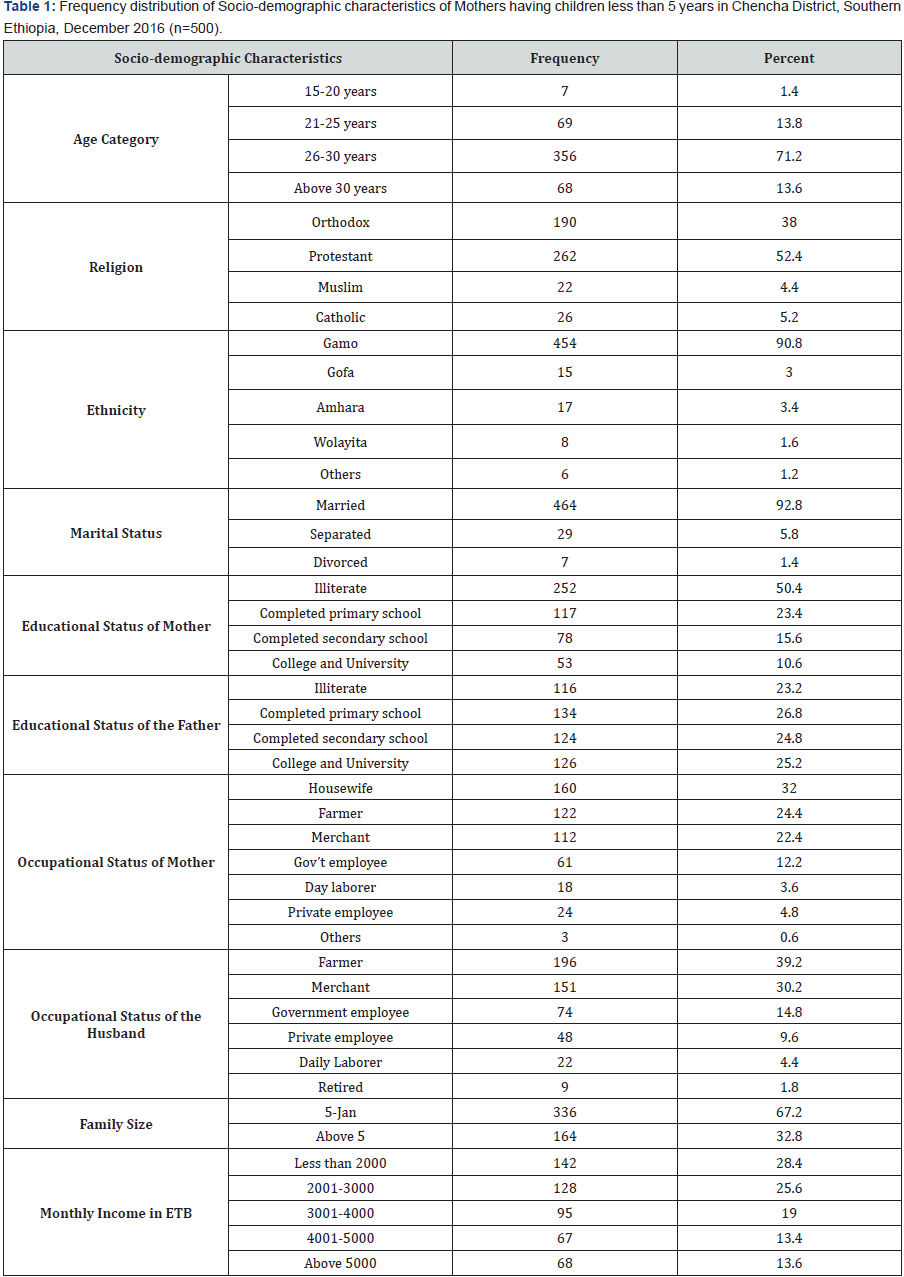
Obstetric characteristics of the respondents
Majority 376(75.2%) of women had married at age of 20- 24 years. mean age of first marriage was 21.3020 (2.18457) years, ranging from 17-32 years. Regarding Age at first pregnancy majority 390(78.0%) and mean age at pregnancy was 21.6 2.13192 Years, ranging from 17-32. With regard to outcomes of pregnancy most 469(93.8%) had live birth followed by 14(2.8%) abortion. Among mothers who were pregnant during study period majority 43(79.6%) started ANC follow-up. Most of mothers 470(94.0%) reported that their last pregnancy was planned and most of them reported that they had received ANC service for this pregnancy, however only about one third 147(33.7%) had received ANC service for times. Majority 348(69.6%) had delivered their last baby in home with most common mode of delivery being spontaneous vaginal delivery 457(91.4%). Regarding knowledge and attitude of the mother 291(58.2%) and 379(75.8%) had adequate knowledge about institutional delivery and positive attitude about it respectively (Table 2).
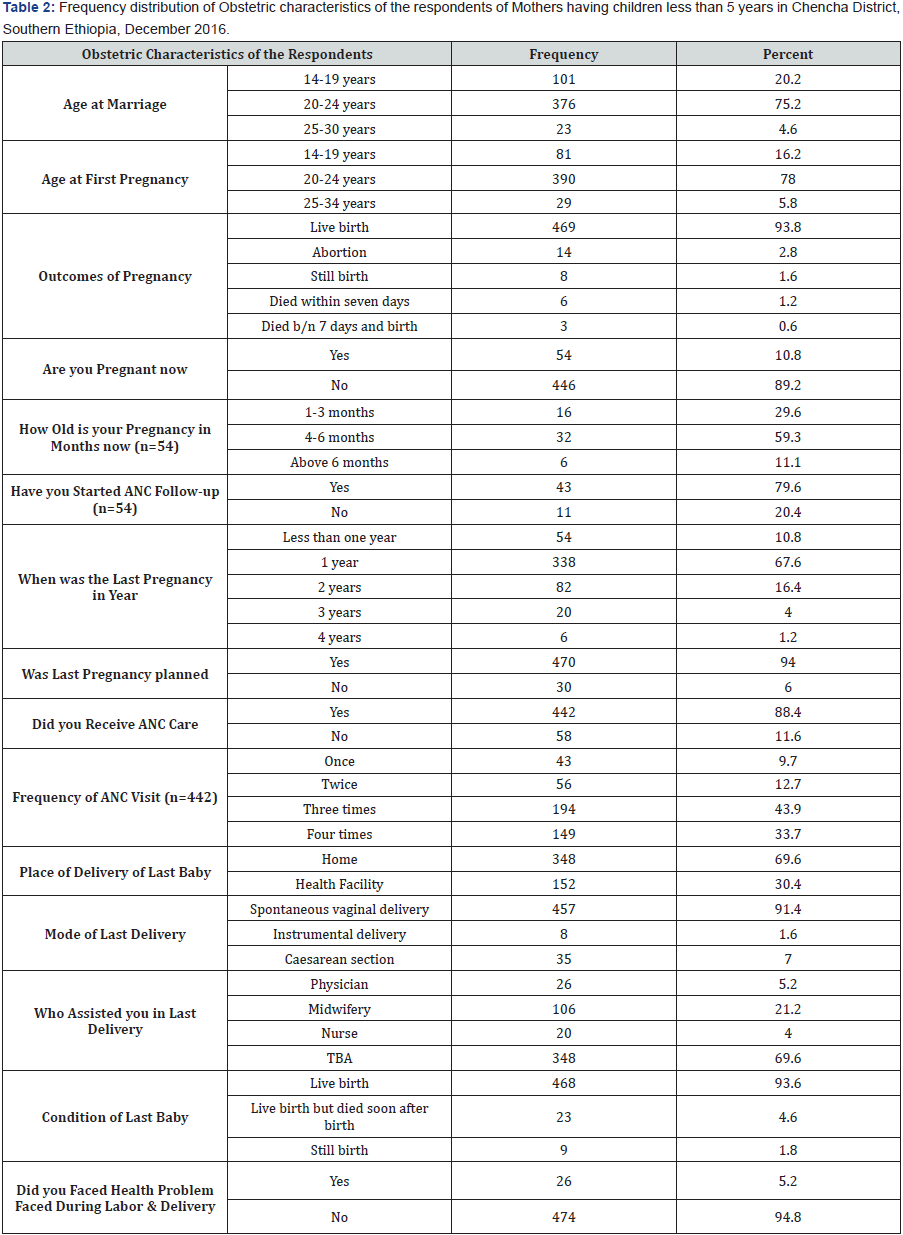
Regarding reported reasons of why mothers prefer home delivery majority 138(39.7%) reported previous home delivery was normal, 121(34.8%) reported labor was small and short, 36(10.3%) they were told that there pregnancy was normal and 21(6.0%) lack of transport and presence of traditional birth attendants (Figure 1).
Regarding health facility related factors why mothers prefer to give birth at home were 154(44.3%) health facility is too far, 146(42.0%) poor quality service, 32(9.2%) no female provider at health facility and 16(4.6%) unwelcoming approach of health care providers (Figure 2).

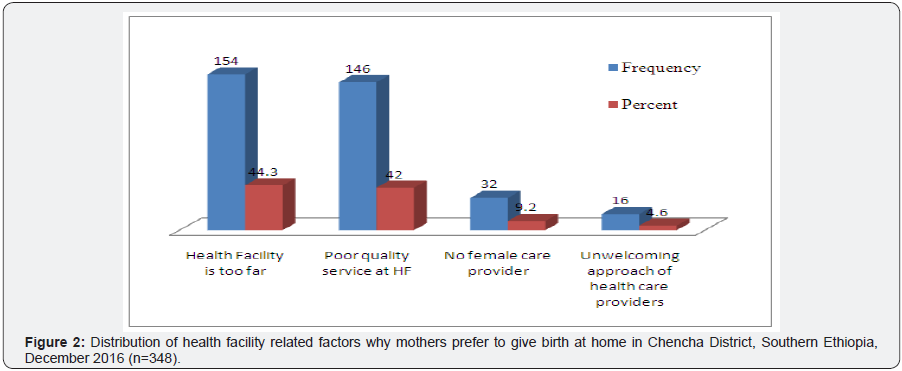
Concerning reasons why mothers give birth at health facility more than one third 37.0% reported need better service, 28% reported previous better outcome in health facility delivery, 14% difficult labor and 7.0% bad outcome with previous home delivery (Figure 3).
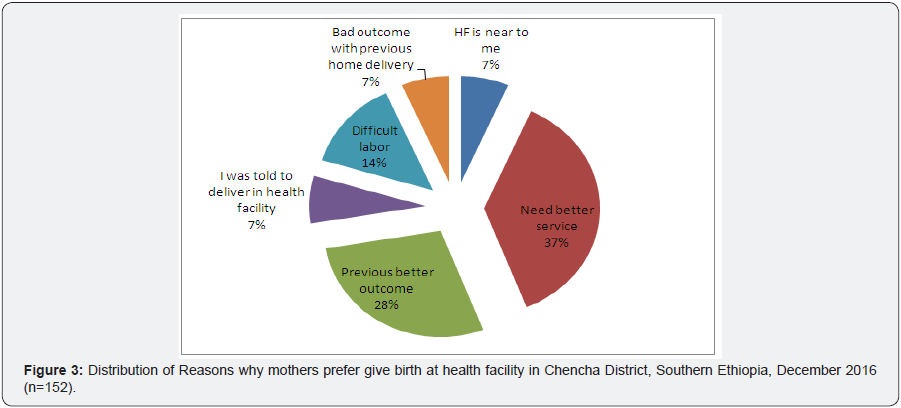
Concerning Health problem faced During Labor & immediately after delivery the most common problem were 8(30.8%), 6(23.1%), 3(11.5%) and 3(11.5%) retained placenta, prolonged labor, mal-presentation and excessive vaginal bleeding respectively (Figure 4).Regarding the birth order the last pregnancy of 193(39.0%), 170(34.0%), 118(23.0%) and 19 (4.0%) of mothers was third, fourth and above, second and first respectively (Figure 5).
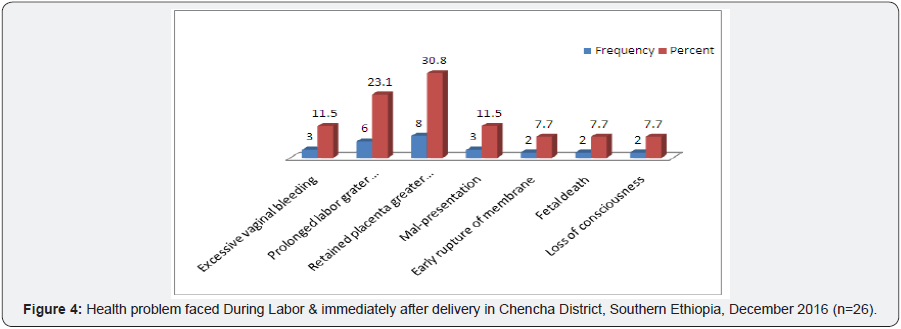

Knowledge about pregnancy, labor and delivery service
Mothers were asked a series of questions regarding their knowledge about pregnancy, labor and delivery service and most of them 446(89.2%) reported that they know health risks associated with pregnancy, more than one half 291(58.2%) know danger signs of pregnancy, 295(59.0%) know danger signs of labor, 387(77.4%) reported having birth at home has associated risks and they also reported that having birth at health facility has associated benefit. Regarding risks associated with risks during pregnancy about one half 214(48.0%) reported pregnancy related disease, 157(35.2%) reported maternal death and 75(16.8%) fetal death. Concerning reported danger signs leakage of amniotic fluid without labor 57(19.6%), swelling of leg/face 46(15.8%) followed by increased BP 37(12.7%) and 34(11.7%) severe headache and excessive weight gain. With regard to reported danger signs of labor, prolonged labor greater than 12 hrs 70(23.7%), Increased BP 65(22.0%) followed by convulsion 35(11.9%) and Mal-presentation 35(11.9%). Among reported benefits of giving birth at Health facility early detection of problems 89(23.0%), low maternal mortality 69(17.8%) followed by low maternal exhaustion 64(16.5%). Overall knowledge of mother about pregnancy, labor and delivery service was adequate 291(58.2%) and poor for 209(41.8%) (Table 3).
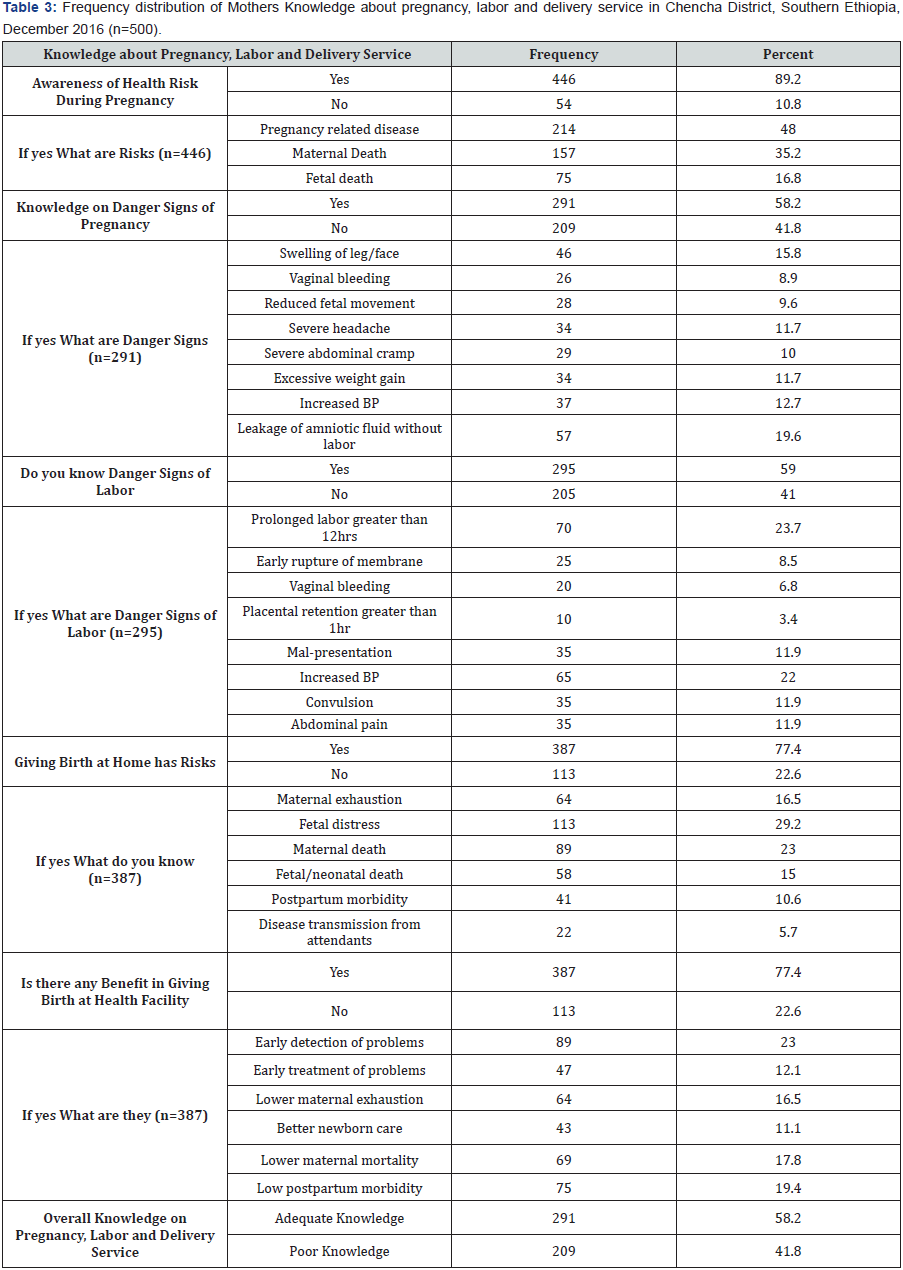
Attitude about pregnancy, labor and delivery service
Mothers were asked series of questions concerning their perception about pregnancy, labor and delivery complications and majority reported that complication of labor were preventable and treatable 380(76.0%) and 439(87.9%) respectively. most of respondents 400(80.0%) reported that every women were at risk of developing pregnancy complication. Over all attitude of mothers about pregnancy, labor and delivery was positive for 379(75.8%) and negative for 121(24.2%) (Table 4).

Note: Very agree and Agree were labeled as positive and assigned value “1” and Disagree and very disagree were labeled as negative attitude and assigned value “0”. The Overall Attitude was considered positive if all questions were assigned value “1” and respondents were labeled to negative attitude if any of questions is assigned “0.
Social and health system factors and women decision-making
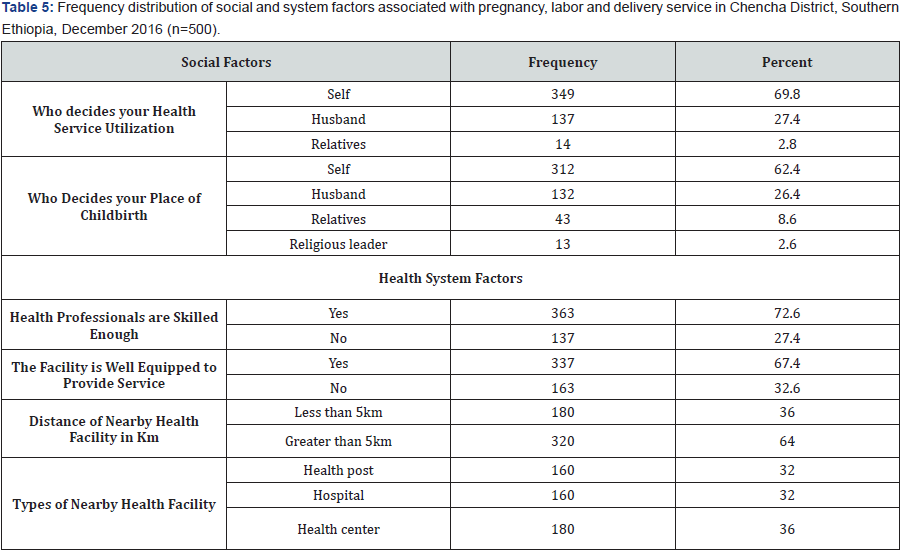
Most of mothers reported that they decide on utilization of health service and place of delivery 349(69.8%) and 312(62.4%) respectively. Concerning health system related factors majority of respondents 363(72.6%), 337( 67.4%), 320(64.0%) and 180(36.0%) reported that Health professionals are skilled enough, The facility is well equipped to provide service, distance from health facility was greater than 5km and nearby health facility was health center respectively (Table 5).
Factors associated with skilled birth attendance
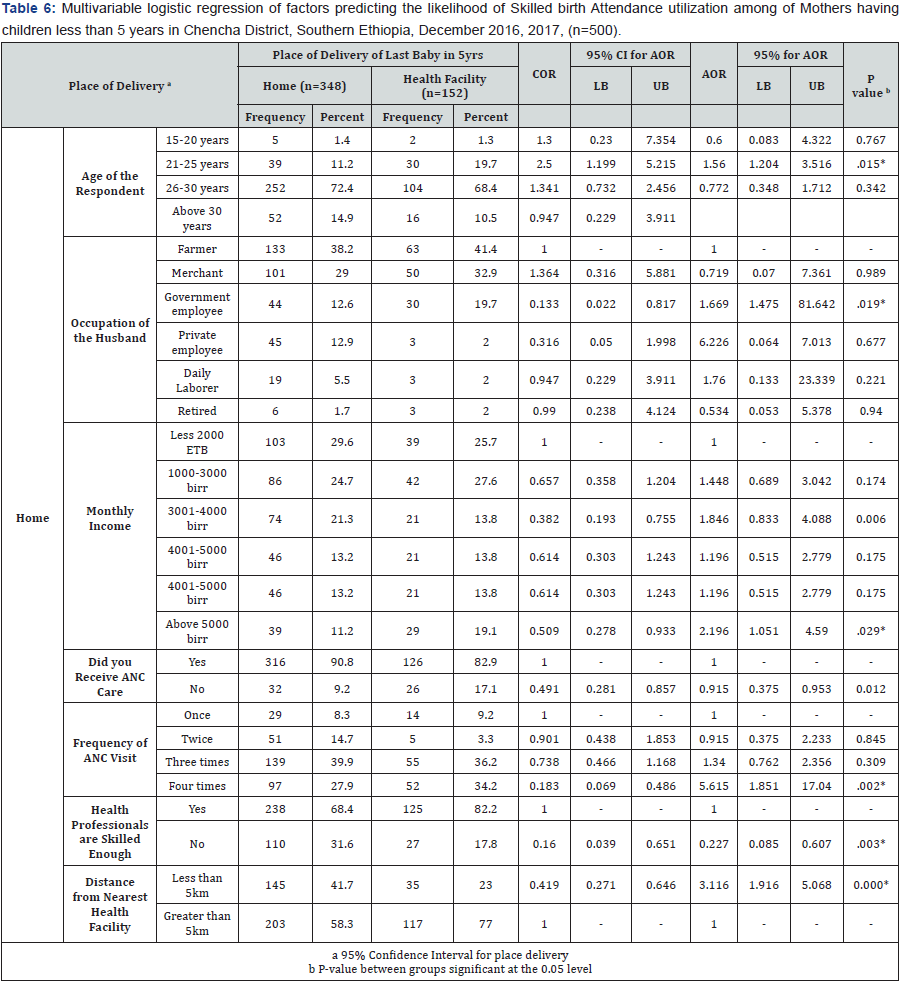
Binary logistic regression was done to identify association between skilled birth attendance utilization and independent variables and variables that have shown statistical significance at P-value less than 0.05 were entered into multinomial logistic regression to rule out confounders and identify independent predictors of skilled birth attendance utilization practice. Age of the mother 21-25 years were 1.5 times [AOR=1.56 (1.204-3.516) more likely to deliver their babies in health facility than those above 30 years of age, Mothers with government employed husband were 1.6 times [AOR=1.669 (1.475-81.642) more likely more likely to deliver their babies in health facility than farmers, mothers with monthly income above 5000 ETB were 2 times [AOR=2.196 (1.051-4.590) more likely to deliver their babies in health facility than those earning below 200 ETB per month, Mothers with no ANC follow-up were less [AOR=0.915 (0.375-0.953) likely to deliver in health facility than those who have ANC follow-up, Mothers with four times ANC visit were 5 times more [AOR=5.615 (1.851-17.040) likely to deliver in health facility than those with one time follow-up, Mothers who reported health professionals are not well skilled were less [AOR=0.227 (0.085-0.607) likely to deliver in health facility than those who reported professionals are well skilled, Mothers with nearest health facility in less than 5 km distance were 3 times more [AOR=3.116 (1.916-5.068) likely to deliver in health facility than those with more than 5km distance (Table 6).
Conceptual Frame Work
(Figure 6 & 7)

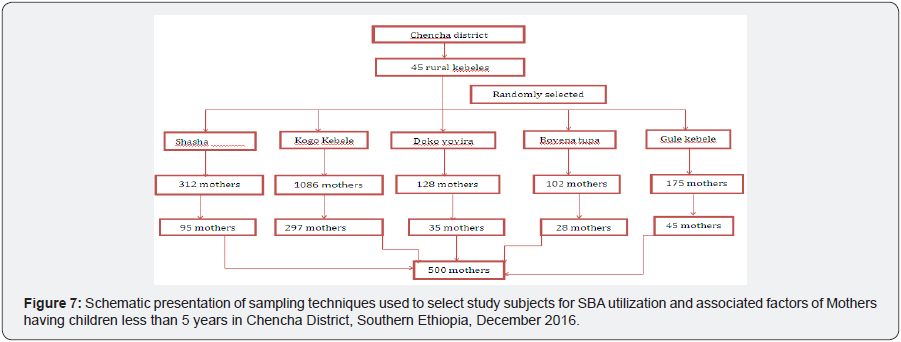
Discussion
This study revealed the status and independent predictors of skilled birth attendance by rural mothers in Chencha district, Gamo Gofa zone southern Ethiopia. The point prevalence of institutional delivery was 152(30.4%) and Majority 348(69.6%) had delivered their last baby in home with most common mode of delivery being spontaneous vaginal delivery 457(91.4%). This is higher than study conducted in southern Ethiopia showed that the prevalence of skilled birth attendance was 148(26.8%) [22] and findings from other rural communities Ethiopia For example 21% of births to rural mothers were assisted by a skilled provider and 20% were delivered in a health facility [6]. However this is lower than study conducted in North West Ethiopia showed that 38.2 % of women gave birth in health facilities for their most recent birth while the most 223 (61.8 %) delivered at home [14]. The variation could be explained by difference in sociodemographic variables among study participants and difference in tools used by researchers. This study showed that mothers knowledge about pregnancy, labour and delivery was adequate for the 291(58.2%) of them. However knowledge of mothers was not associated with skilled birth attendance. This could be due others factors deterring the use skilled birth attendance like maternal age, monthly income, occupation, skill of professionals and distance from health facility.
This study revealed that the major reasons why mothers give birth at health facility include; 37.0% need better service, 28% previous better outcome in health facility delivery, 14% difficult labor and 7.0% bad outcome with previous home delivery. This is similar to findings from north west Ethiopia showed that major reasons of institutional delivery were fear of complications (77.5%), to get better service (56.5%) safe and clean delivery (46.4%) and they were communicated to deliver at health facilities during ANC attendance, 47(35.5%) [14].
Age of the mother 21-25 years were 1.5 times [AOR=1.56 (1.204-3.516) more likely to deliver their babies in health facility than those above 30 years of age. This in line with findings from different studies conducted in north west Ethiopia indicated that mothers with lower age at first pregnancy, having more than one previous pregnancies, with in more than one birth order, received ANC service, found to be significantly associated with safe delivery service utilization [18]. Study conducted in southern Ethiopia showed that Mothers with the age range of 15-19 yrs were about five times more likely to give birth at health facility [22]. This could be due to improved access to reproductive health information for young generation through Medias like, TV, radio or internet than those old aged mothers.
Mothers with government employed husband were 1.6 times [AOR=1.669 (1.475-81.642) more likely more likely to deliver their babies in health facility than farmers. This is in line with studies conducted in different regions of Ethiopia indicated that maternal education family size, husband occupation and education were all significantly associated with health facility delivery [16].
Mothers with monthly income above 5000 ETB were 2 times [AOR=2.196 (1.051-4.590) more likely to deliver their babies in health facility than those earing below 200 ETB per month. This is in line with EDHS findings household wealth status is highly correlated with whether their deliveries are assisted by a skilled provider and whether they are delivered in a health facility [6]. This could be due to increased wealth of family could help other factors hindering institutional delivery like distance from health facility by that they can pay transportation cost to get ANC service or attend delivery in health facility.
Mothers with no ANC follow-up were less [AOR=0.915 (0.375- 0.953) likely to deliver in health facility than those who have ANC follow-up, Mothers with four times ANC visit were 5 times more [AOR=5.615 (1.851-17.040) likely to deliver in health facility than those with one time follow-up. This similar with findings from Study conducted in North West Ethiopia showed that mothers who received ANC service, birth complications in previous and immediate pregnancies and had every used professionally assisted delivery in preceding delivery were commonly found to be significantly associated with safe delivery service utilization [18]. Antenatal care service utilization is independent predictor of utilization of institutional delivery. Mothers making one or more ANC visits were more likely to use delivery care service. This might be due to advice from healthcare workers during antenatal care increases a woman’s use of institutional delivery. The healthcare workers could provide good information regarding safe health care delivery and encourage women to deliver at health facility. A previous study in Ethiopia found that proper counseling and advice to deliver at health care facility increased institutional delivery [19].
Mothers who reported health professionals are not well skilled were less [AOR=0.227 (0.085-0.607) likely to deliver in health facility than those who reported professionals are well skilled. This is similar with study in Cambodia indicated that delivery with skilled attendant at the preceding delivery was a significant determinant for subsequent use of skilled attendant. Once a woman has delivered with the aid of an unskilled attendant, she is five to seven times less likely to seek skilled help than a primipara [20].
Mothers with nearest health facility in less than 5km distance were 3 times more [AOR=3.116 (1.916-5.068) likely to deliver in health facility than those with more than 5km distance. This similar with findings from Bahir Dar, showed that Mothers who gave birth at home have different reasons 46% of them think giving birth at health facility has no necessity, 33% of mothers said the service at health facility is not customary, 21% of the mother said that the health facility was either too far or that they did not have transportation. Rural women were more likely to report that facility deliveries are not customary 33%, health facilities were too far or they had no transportation 22% [23].
Conclusion
In conclusion this study revealed that prevalence of skilled birth attendance below one third. ANC visit for four and more times low, Mothers knowledge about pregnancy, labour and delivery was low. Age of the mother 21-25 years, Mothers with government employed husband, mothers with monthly income above 5000 ETB, Mothers with ANC follow-up, Mothers with four times ANC visit, Mothers who reported health professionals are not well skilled and Mothers with nearest health facility in less than 5km distance were predictors of skilled birth attendance utilization.
Strengths and Limitations of the Study
Strengths
Random sampling technique was employed. i.e., random selection of the Villages, Data collectors speaks local languages and was the same sex with study subjects to minimize information biases and Standardized questionnaire based on similar studies.
Limitations
The study design was cross-sectional and determinants of skilled birth attendance cannot assessed, there could be recall bias, since the women were asked for events within the last one year prior to the survey.
Recommendations
Based on the findings of this study, the following specific recommendations were made to respective bodies.
To health care providers
- The knowledge of mothers regarding pregnancy, labour and delivery was low; this recalls Health care providers should provide information on risks of pregnancy, benefits of giving birth at health facilities, risk of giving birth at home to mothers, family members and the community.
- Mothers who had ANC follow-up four and more times were still low professionals should promote it to four and more and linked with delivery care.
- Providing standardized care for clients is the basic concern for every professional and it is important to update skill and knowledge to provide care.
To woreda health sector officials
- Improving access and quality of health service were independent predictors of skilled birth attendance. Therefore availing basic supplies and stuffing with trained health professionals)
- More work is expected to achieve the national need i.e. creating home delivery free village and preventing all preventable maternal deaths in 2030.
To community
a) Community leaders should encourage health facility visit during pregnancy, labour and delivery and discourage involvement of traditional birth attendants on delivery assistances.
For more articles in Open Access Journal of Case Studies please click on: https://juniperpublishers.com/jojcs/index.php




No comments:
Post a Comment